Attached files
| file | filename |
|---|---|
| EX-99.2 - EX-99.2 - DYCOM INDUSTRIES INC | dyfy2022q2non-gaapreconcil.htm |
| 8-K - 8-K - DYCOM INDUSTRIES INC | dy-20210913.htm |
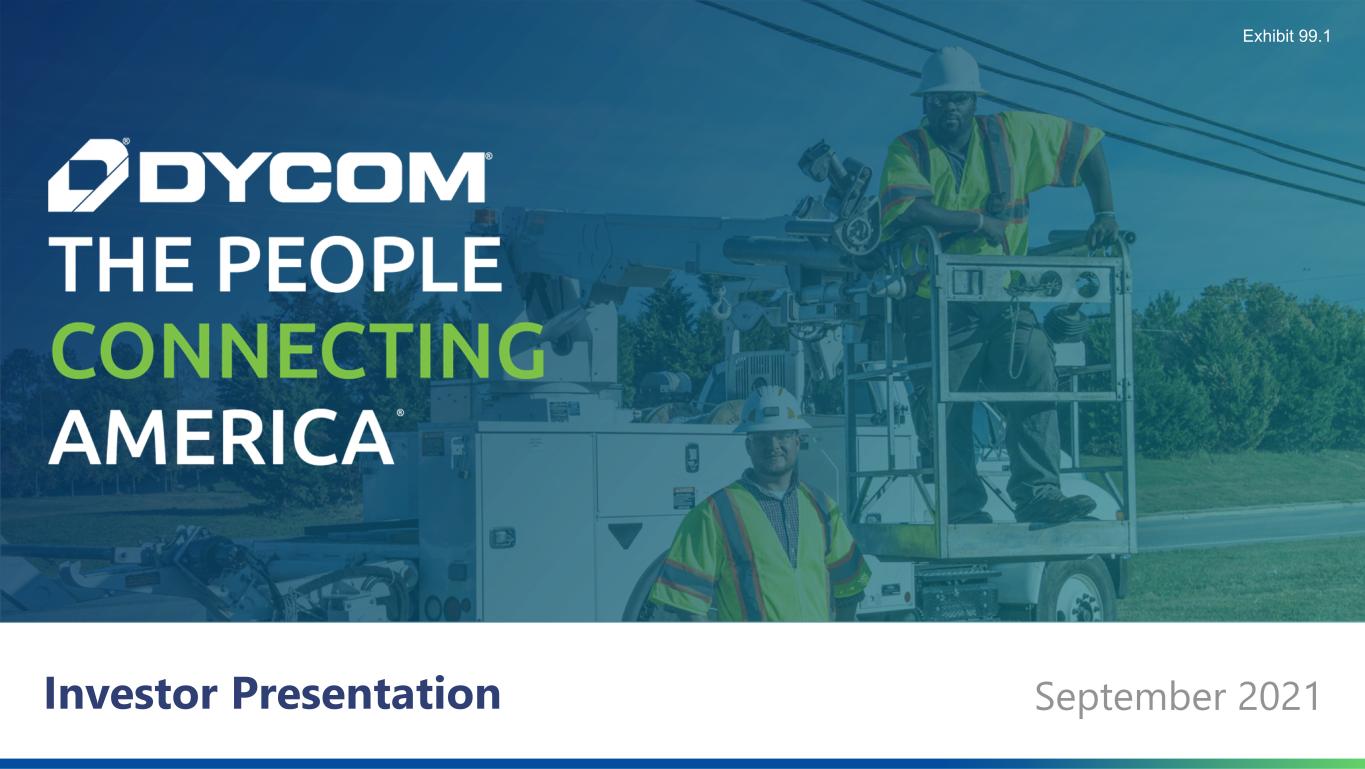
September 2021Investor Presentation Exhibit 99.1
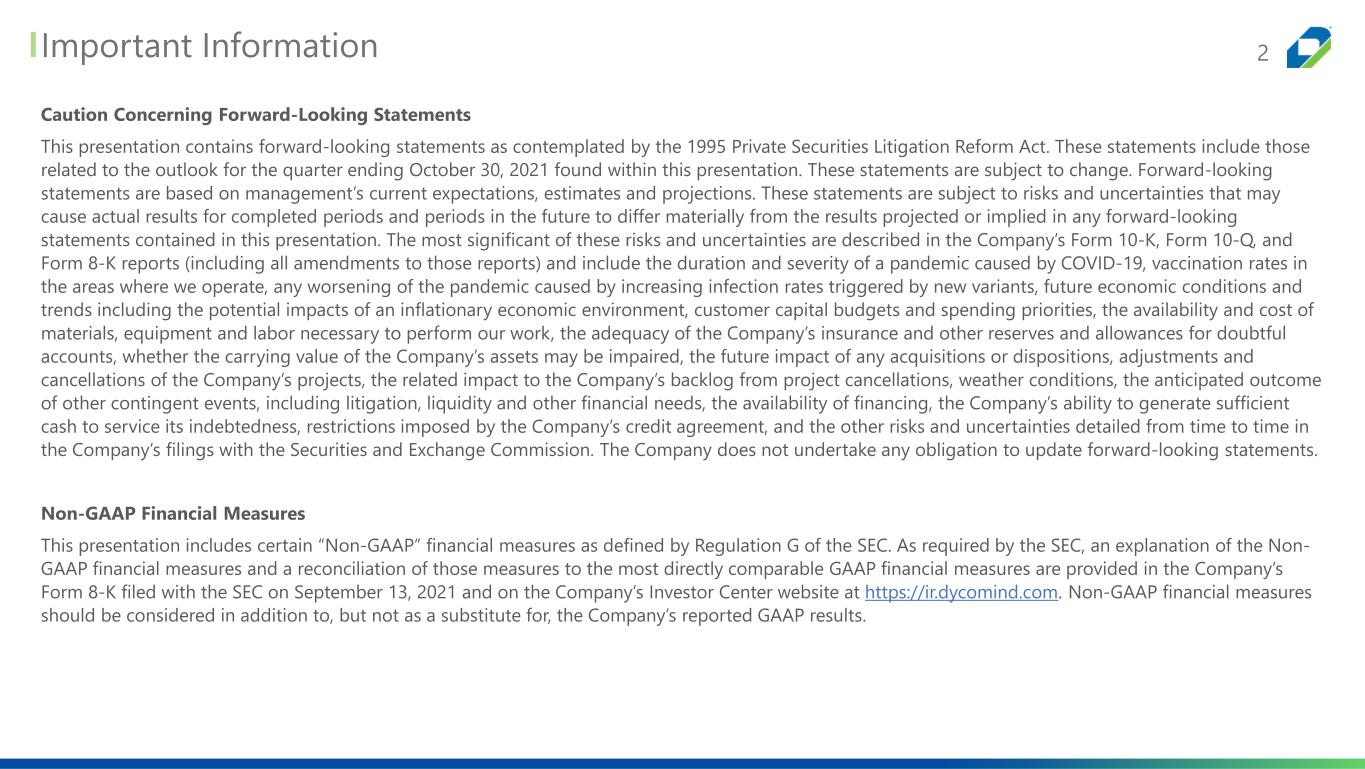
Caution Concerning Forward-Looking Statements This presentation contains forward-looking statements as contemplated by the 1995 Private Securities Litigation Reform Act. These statements include those related to the outlook for the quarter ending October 30, 2021 found within this presentation. These statements are subject to change. Forward-looking statements are based on management’s current expectations, estimates and projections. These statements are subject to risks and uncertainties that may cause actual results for completed periods and periods in the future to differ materially from the results projected or implied in any forward-looking statements contained in this presentation. The most significant of these risks and uncertainties are described in the Company’s Form 10-K, Form 10-Q, and Form 8-K reports (including all amendments to those reports) and include the duration and severity of a pandemic caused by COVID-19, vaccination rates in the areas where we operate, any worsening of the pandemic caused by increasing infection rates triggered by new variants, future economic conditions and trends including the potential impacts of an inflationary economic environment, customer capital budgets and spending priorities, the availability and cost of materials, equipment and labor necessary to perform our work, the adequacy of the Company’s insurance and other reserves and allowances for doubtful accounts, whether the carrying value of the Company’s assets may be impaired, the future impact of any acquisitions or dispositions, adjustments and cancellations of the Company’s projects, the related impact to the Company’s backlog from project cancellations, weather conditions, the anticipated outcome of other contingent events, including litigation, liquidity and other financial needs, the availability of financing, the Company’s ability to generate sufficient cash to service its indebtedness, restrictions imposed by the Company’s credit agreement, and the other risks and uncertainties detailed from time to time in the Company’s filings with the Securities and Exchange Commission. The Company does not undertake any obligation to update forward-looking statements. Non-GAAP Financial Measures This presentation includes certain “Non-GAAP” financial measures as defined by Regulation G of the SEC. As required by the SEC, an explanation of the Non- GAAP financial measures and a reconciliation of those measures to the most directly comparable GAAP financial measures are provided in the Company’s Form 8-K filed with the SEC on September 13, 2021 and on the Company’s Investor Center website at https://ir.dycomind.com. Non-GAAP financial measures should be considered in addition to, but not as a substitute for, the Company’s reported GAAP results. Important Information 2
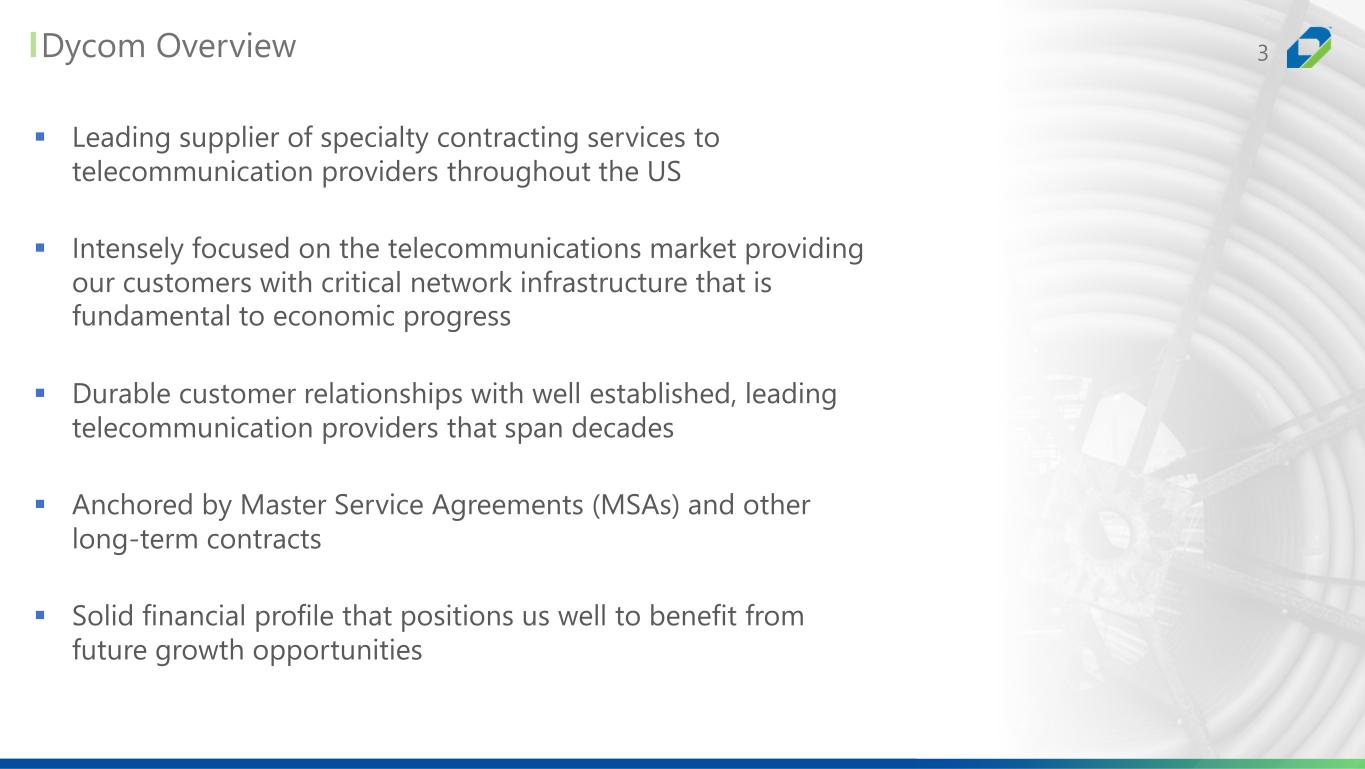
3Dycom Overview Leading supplier of specialty contracting services to telecommunication providers throughout the US Intensely focused on the telecommunications market providing our customers with critical network infrastructure that is fundamental to economic progress Durable customer relationships with well established, leading telecommunication providers that span decades Anchored by Master Service Agreements (MSAs) and other long-term contracts Solid financial profile that positions us well to benefit from future growth opportunities
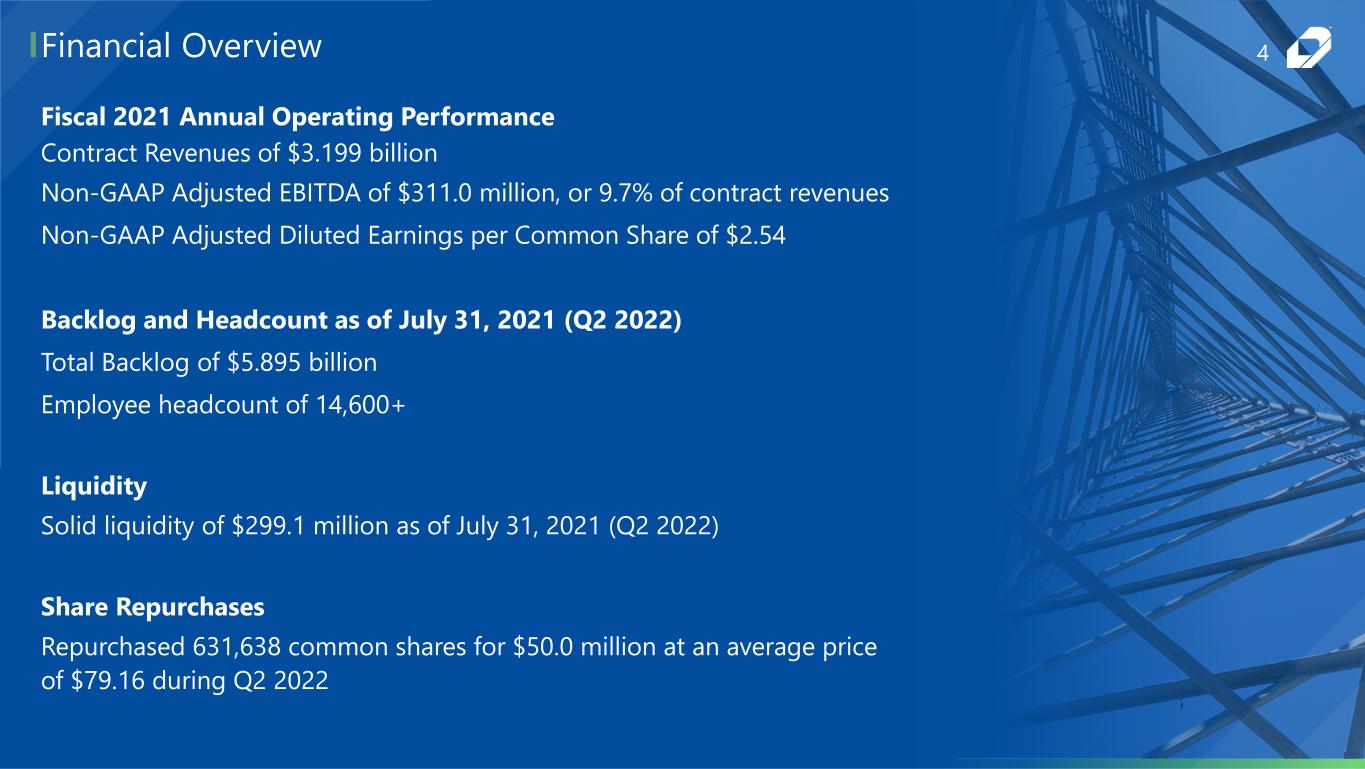
Fiscal 2021 Annual Operating Performance Contract Revenues of $3.199 billion Non-GAAP Adjusted EBITDA of $311.0 million, or 9.7% of contract revenues Non-GAAP Adjusted Diluted Earnings per Common Share of $2.54 Backlog and Headcount as of July 31, 2021 (Q2 2022) Total Backlog of $5.895 billion Employee headcount of 14,600+ Liquidity Solid liquidity of $299.1 million as of July 31, 2021 (Q2 2022) Share Repurchases Repurchased 631,638 common shares for $50.0 million at an average price of $79.16 during Q2 2022 4Financial Overview
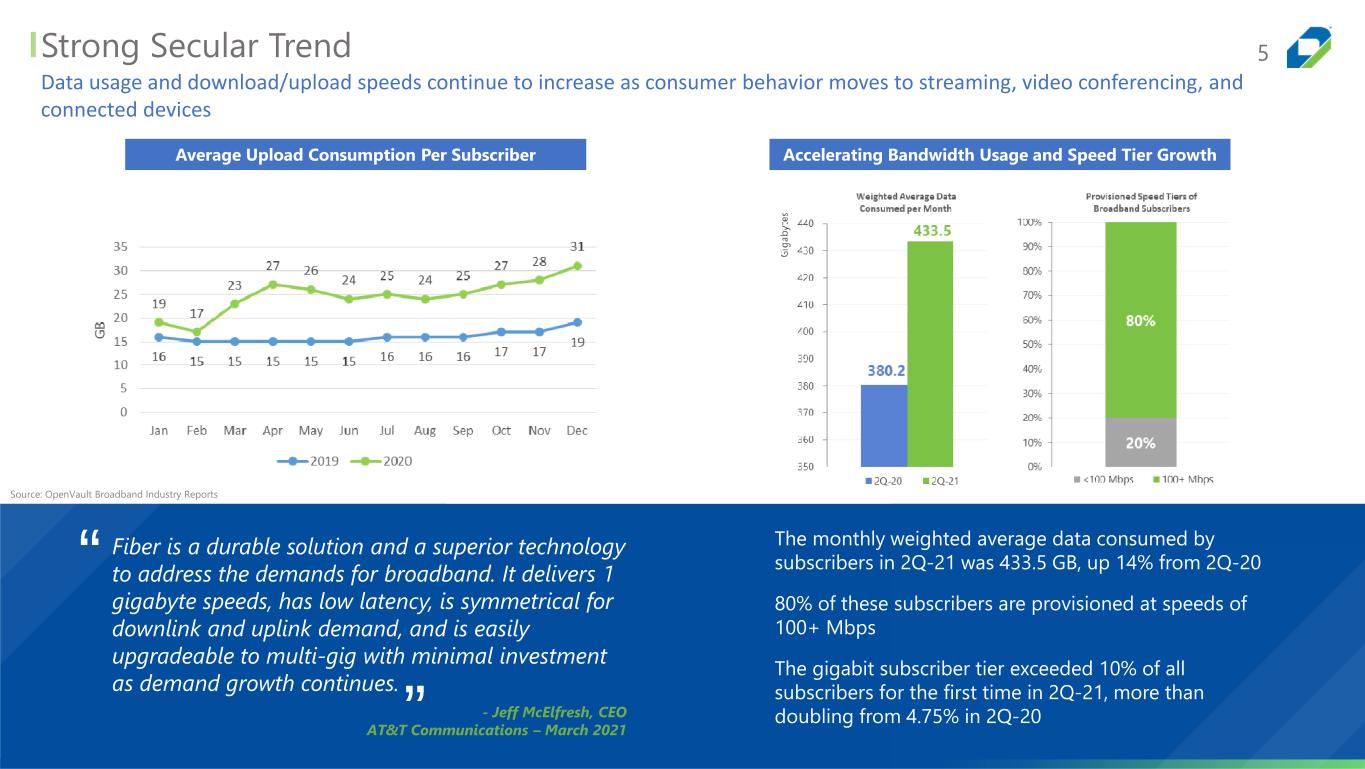
5Strong Secular Trend Average Upload Consumption Per Subscriber Accelerating Bandwidth Usage and Speed Tier Growth The monthly weighted average data consumed by subscribers in 2Q-21 was 433.5 GB, up 14% from 2Q-20 80% of these subscribers are provisioned at speeds of 100+ Mbps The gigabit subscriber tier exceeded 10% of all subscribers for the first time in 2Q-21, more than doubling from 4.75% in 2Q-20 Source: OpenVault Broadband Industry Reports Fiber is a durable solution and a superior technology to address the demands for broadband. It delivers 1 gigabyte speeds, has low latency, is symmetrical for downlink and uplink demand, and is easily upgradeable to multi-gig with minimal investment as demand growth continues. Data usage and download/upload speeds continue to increase as consumer behavior moves to streaming, video conferencing, and connected devices ” “ - Jeff McElfresh, CEO AT&T Communications – March 2021
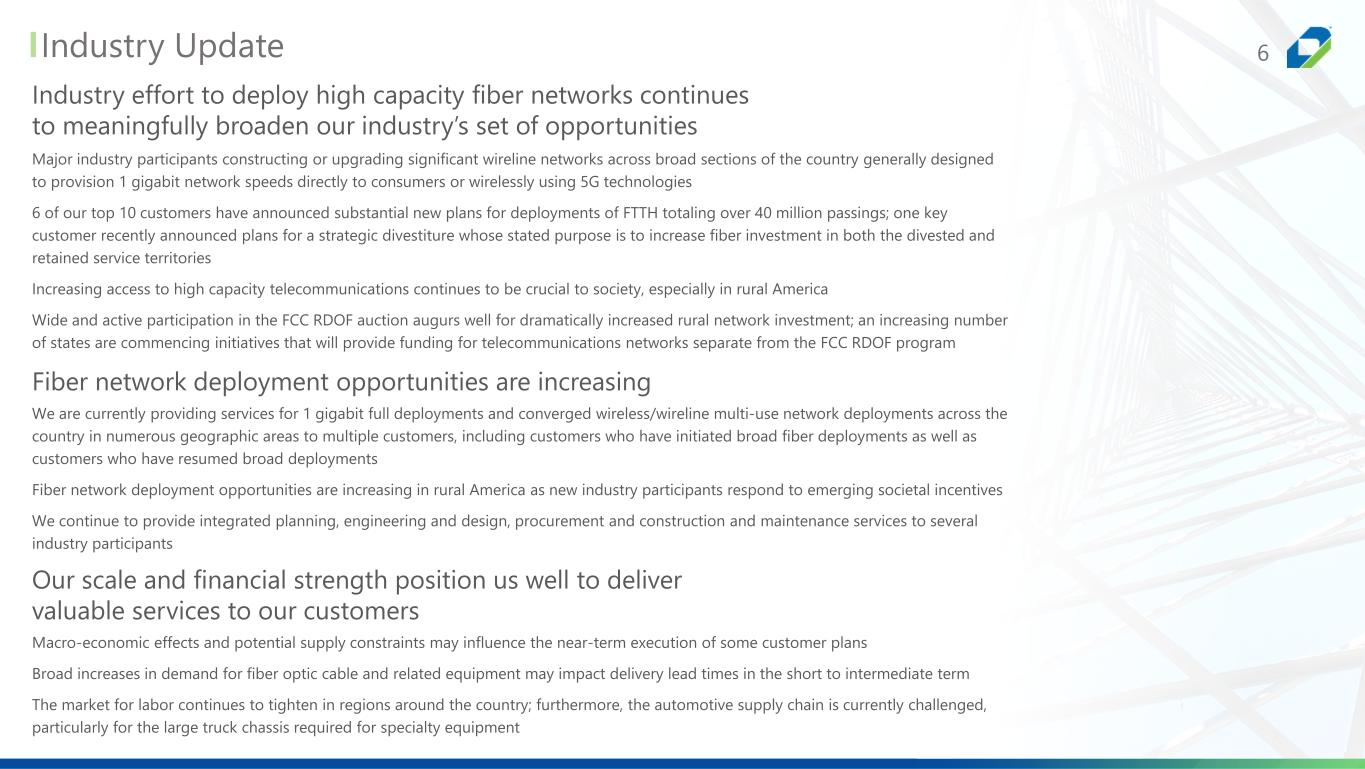
6Industry Update Major industry participants constructing or upgrading significant wireline networks across broad sections of the country generally designed to provision 1 gigabit network speeds directly to consumers or wirelessly using 5G technologies 6 of our top 10 customers have announced substantial new plans for deployments of FTTH totaling over 40 million passings; one key customer recently announced plans for a strategic divestiture whose stated purpose is to increase fiber investment in both the divested and retained service territories Increasing access to high capacity telecommunications continues to be crucial to society, especially in rural America Wide and active participation in the FCC RDOF auction augurs well for dramatically increased rural network investment; an increasing number of states are commencing initiatives that will provide funding for telecommunications networks separate from the FCC RDOF program Industry effort to deploy high capacity fiber networks continues to meaningfully broaden our industry’s set of opportunities Fiber network deployment opportunities are increasing Our scale and financial strength position us well to deliver valuable services to our customers We are currently providing services for 1 gigabit full deployments and converged wireless/wireline multi-use network deployments across the country in numerous geographic areas to multiple customers, including customers who have initiated broad fiber deployments as well as customers who have resumed broad deployments Fiber network deployment opportunities are increasing in rural America as new industry participants respond to emerging societal incentives We continue to provide integrated planning, engineering and design, procurement and construction and maintenance services to several industry participants Macro-economic effects and potential supply constraints may influence the near-term execution of some customer plans Broad increases in demand for fiber optic cable and related equipment may impact delivery lead times in the short to intermediate term The market for labor continues to tighten in regions around the country; furthermore, the automotive supply chain is currently challenged, particularly for the large truck chassis required for specialty equipment
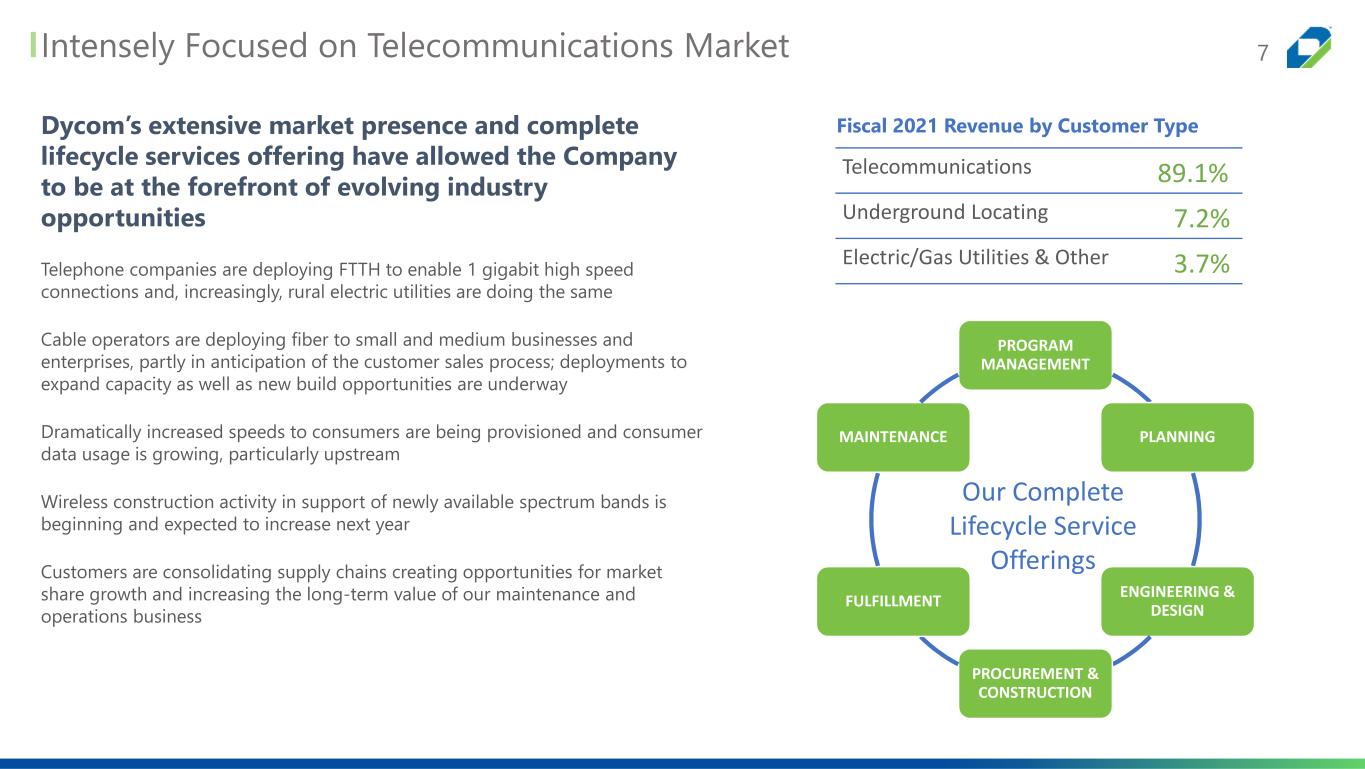
7Intensely Focused on Telecommunications Market Fiscal 2021 Revenue by Customer Type PROGRAM MANAGEMENT PLANNING ENGINEERING & DESIGN PROCUREMENT & CONSTRUCTION FULFILLMENT MAINTENANCE Telecommunications 89.1% Underground Locating 7.2% Electric/Gas Utilities & Other 3.7% Dycom’s extensive market presence and complete lifecycle services offering have allowed the Company to be at the forefront of evolving industry opportunities Telephone companies are deploying FTTH to enable 1 gigabit high speed connections and, increasingly, rural electric utilities are doing the same Cable operators are deploying fiber to small and medium businesses and enterprises, partly in anticipation of the customer sales process; deployments to expand capacity as well as new build opportunities are underway Dramatically increased speeds to consumers are being provisioned and consumer data usage is growing, particularly upstream Wireless construction activity in support of newly available spectrum bands is beginning and expected to increase next year Customers are consolidating supply chains creating opportunities for market share growth and increasing the long-term value of our maintenance and operations business Our Complete Lifecycle Service Offerings
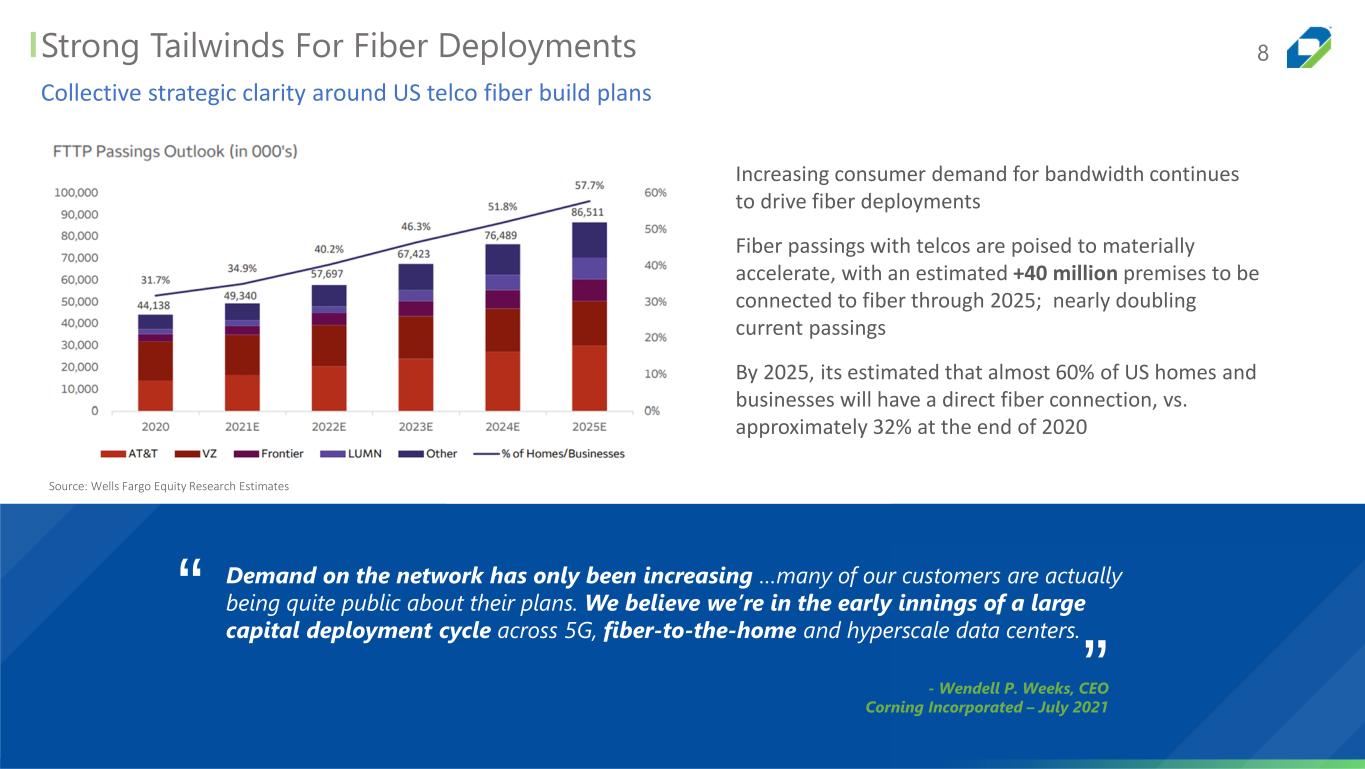
8Strong Tailwinds For Fiber Deployments Source: Wells Fargo Equity Research Estimates Demand on the network has only been increasing …many of our customers are actually being quite public about their plans. We believe we’re in the early innings of a large capital deployment cycle across 5G, fiber-to-the-home and hyperscale data centers. - Wendell P. Weeks, CEO Corning Incorporated – July 2021 “ ” Collective strategic clarity around US telco fiber build plans Increasing consumer demand for bandwidth continues to drive fiber deployments Fiber passings with telcos are poised to materially accelerate, with an estimated +40 million premises to be connected to fiber through 2025; nearly doubling current passings By 2025, its estimated that almost 60% of US homes and businesses will have a direct fiber connection, vs. approximately 32% at the end of 2020
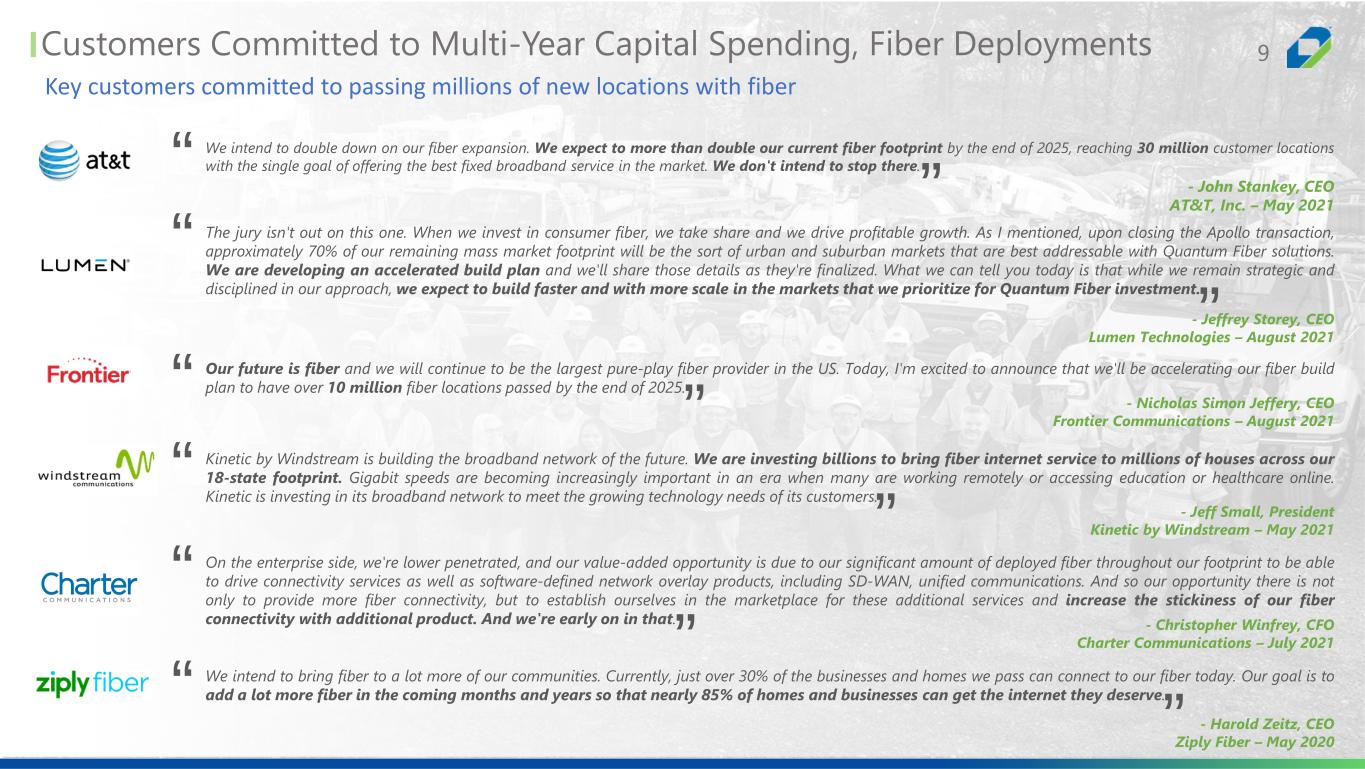
9Customers Committed to Multi-Year Capital Spending, Fiber Deployments We intend to double down on our fiber expansion. We expect to more than double our current fiber footprint by the end of 2025, reaching 30 million customer locations with the single goal of offering the best fixed broadband service in the market. We don't intend to stop there. ” - John Stankey, CEO AT&T, Inc. – May 2021 - Nicholas Simon Jeffery, CEO Frontier Communications – August 2021 Key customers committed to passing millions of new locations with fiber Our future is fiber and we will continue to be the largest pure-play fiber provider in the US. Today, I'm excited to announce that we'll be accelerating our fiber build plan to have over 10 million fiber locations passed by the end of 2025. “ The jury isn't out on this one. When we invest in consumer fiber, we take share and we drive profitable growth. As I mentioned, upon closing the Apollo transaction, approximately 70% of our remaining mass market footprint will be the sort of urban and suburban markets that are best addressable with Quantum Fiber solutions. We are developing an accelerated build plan and we'll share those details as they're finalized. What we can tell you today is that while we remain strategic and disciplined in our approach, we expect to build faster and with more scale in the markets that we prioritize for Quantum Fiber investment. - Jeffrey Storey, CEO Lumen Technologies – August 2021 ” ” “ “ On the enterprise side, we're lower penetrated, and our value-added opportunity is due to our significant amount of deployed fiber throughout our footprint to be able to drive connectivity services as well as software-defined network overlay products, including SD-WAN, unified communications. And so our opportunity there is not only to provide more fiber connectivity, but to establish ourselves in the marketplace for these additional services and increase the stickiness of our fiber connectivity with additional product. And we're early on in that. “ ” - Christopher Winfrey, CFO Charter Communications – July 2021 Kinetic by Windstream is building the broadband network of the future. We are investing billions to bring fiber internet service to millions of houses across our 18-state footprint. Gigabit speeds are becoming increasingly important in an era when many are working remotely or accessing education or healthcare online. Kinetic is investing in its broadband network to meet the growing technology needs of its customers. “ - Jeff Small, President Kinetic by Windstream – May 2021 We intend to bring fiber to a lot more of our communities. Currently, just over 30% of the businesses and homes we pass can connect to our fiber today. Our goal is to add a lot more fiber in the coming months and years so that nearly 85% of homes and businesses can get the internet they deserve. - Harold Zeitz, CEO Ziply Fiber – May 2020 “ ” ”
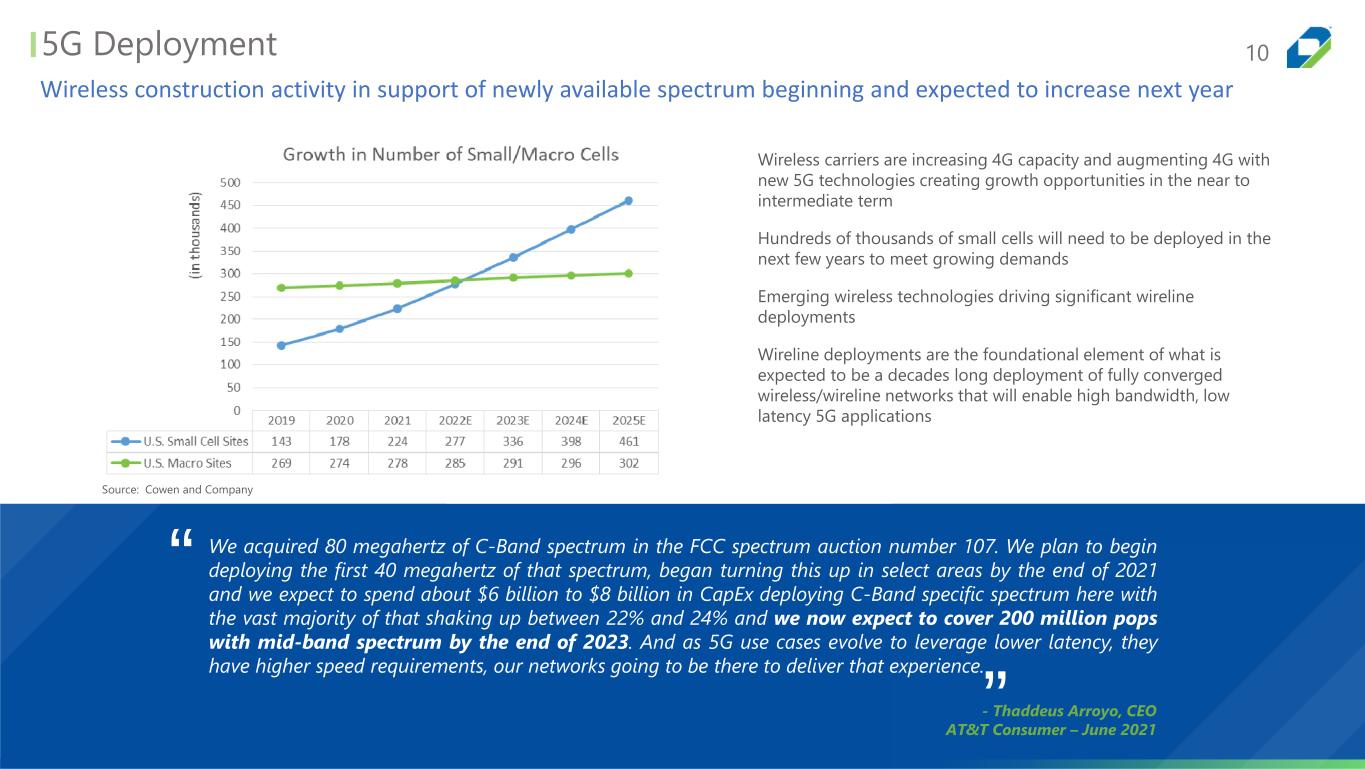
105G Deployment We acquired 80 megahertz of C-Band spectrum in the FCC spectrum auction number 107. We plan to begin deploying the first 40 megahertz of that spectrum, began turning this up in select areas by the end of 2021 and we expect to spend about $6 billion to $8 billion in CapEx deploying C-Band specific spectrum here with the vast majority of that shaking up between 22% and 24% and we now expect to cover 200 million pops with mid-band spectrum by the end of 2023. And as 5G use cases evolve to leverage lower latency, they have higher speed requirements, our networks going to be there to deliver that experience. “ - Thaddeus Arroyo, CEO AT&T Consumer – June 2021 Source: Cowen and Company Wireless carriers are increasing 4G capacity and augmenting 4G with new 5G technologies creating growth opportunities in the near to intermediate term Hundreds of thousands of small cells will need to be deployed in the next few years to meet growing demands Emerging wireless technologies driving significant wireline deployments Wireline deployments are the foundational element of what is expected to be a decades long deployment of fully converged wireless/wireline networks that will enable high bandwidth, low latency 5G applications ” Wireless construction activity in support of newly available spectrum beginning and expected to increase next year
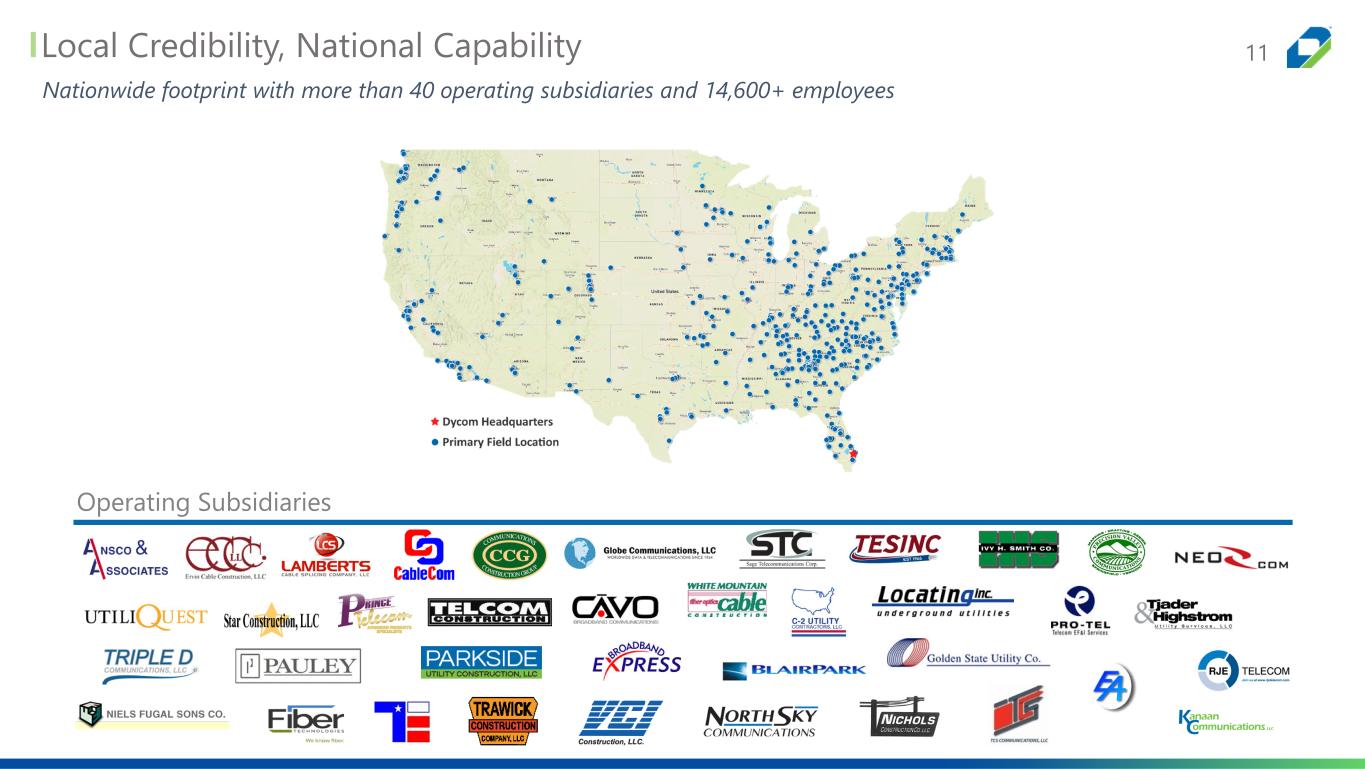
Local Credibility, National Capability Nationwide footprint with more than 40 operating subsidiaries and 14,600+ employees Operating Subsidiaries 11
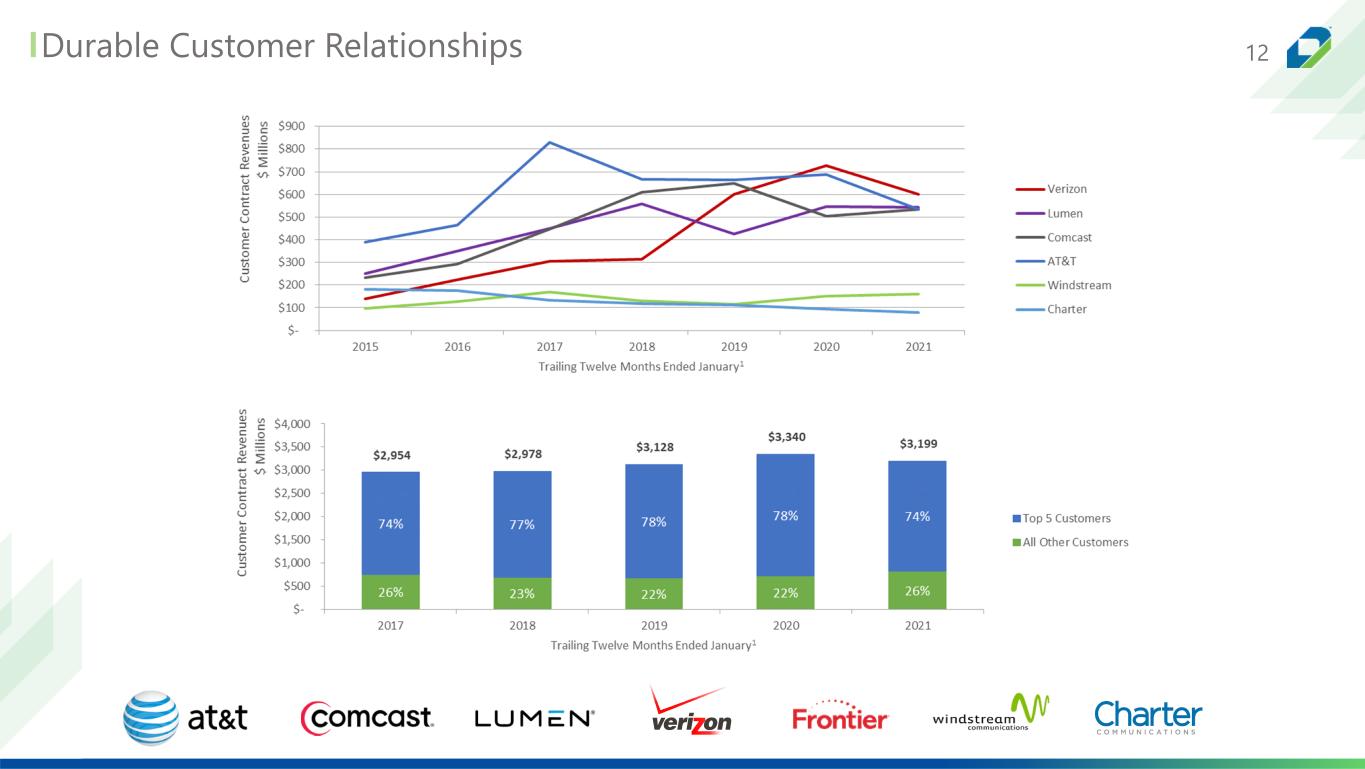
12Durable Customer Relationships
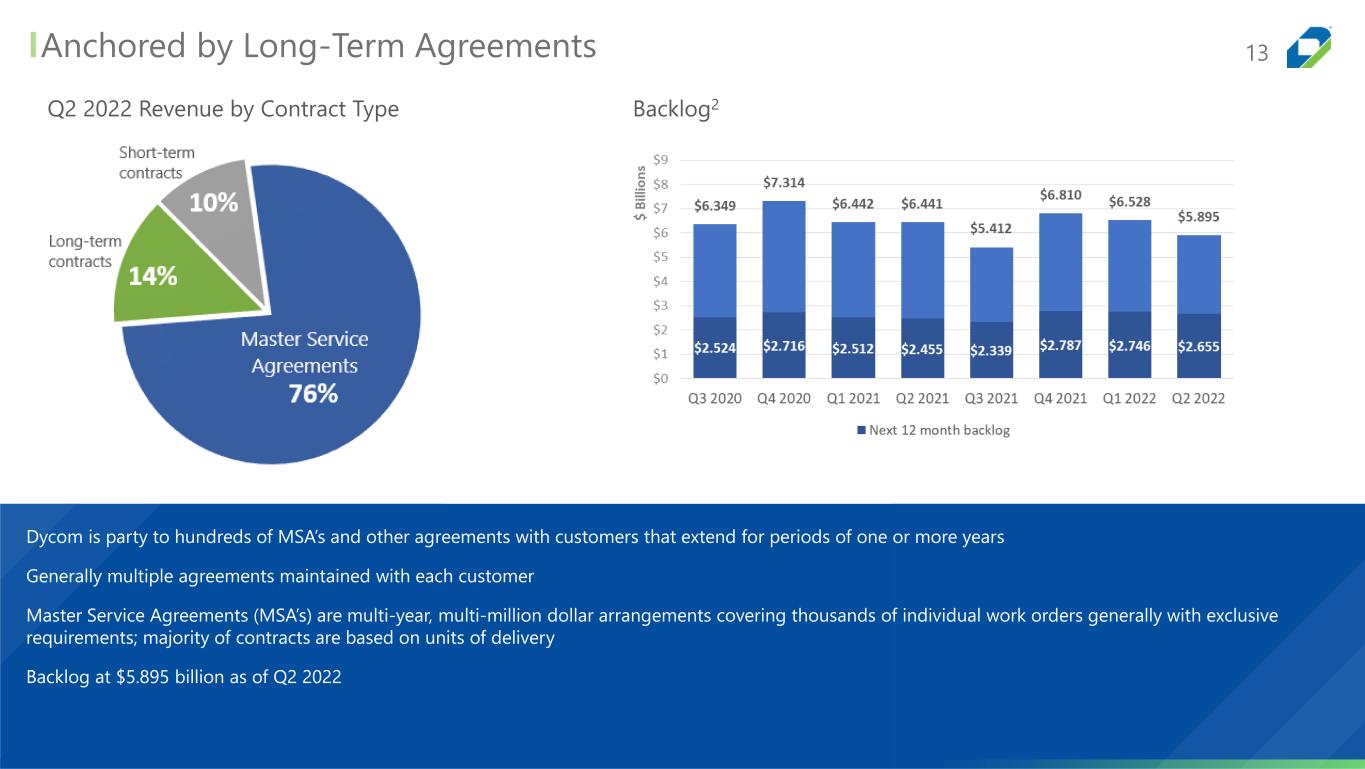
13Anchored by Long-Term Agreements Dycom is party to hundreds of MSA’s and other agreements with customers that extend for periods of one or more years Generally multiple agreements maintained with each customer Master Service Agreements (MSA’s) are multi-year, multi-million dollar arrangements covering thousands of individual work orders generally with exclusive requirements; majority of contracts are based on units of delivery Backlog at $5.895 billion as of Q2 2022 Q2 2022 Revenue by Contract Type Backlog2
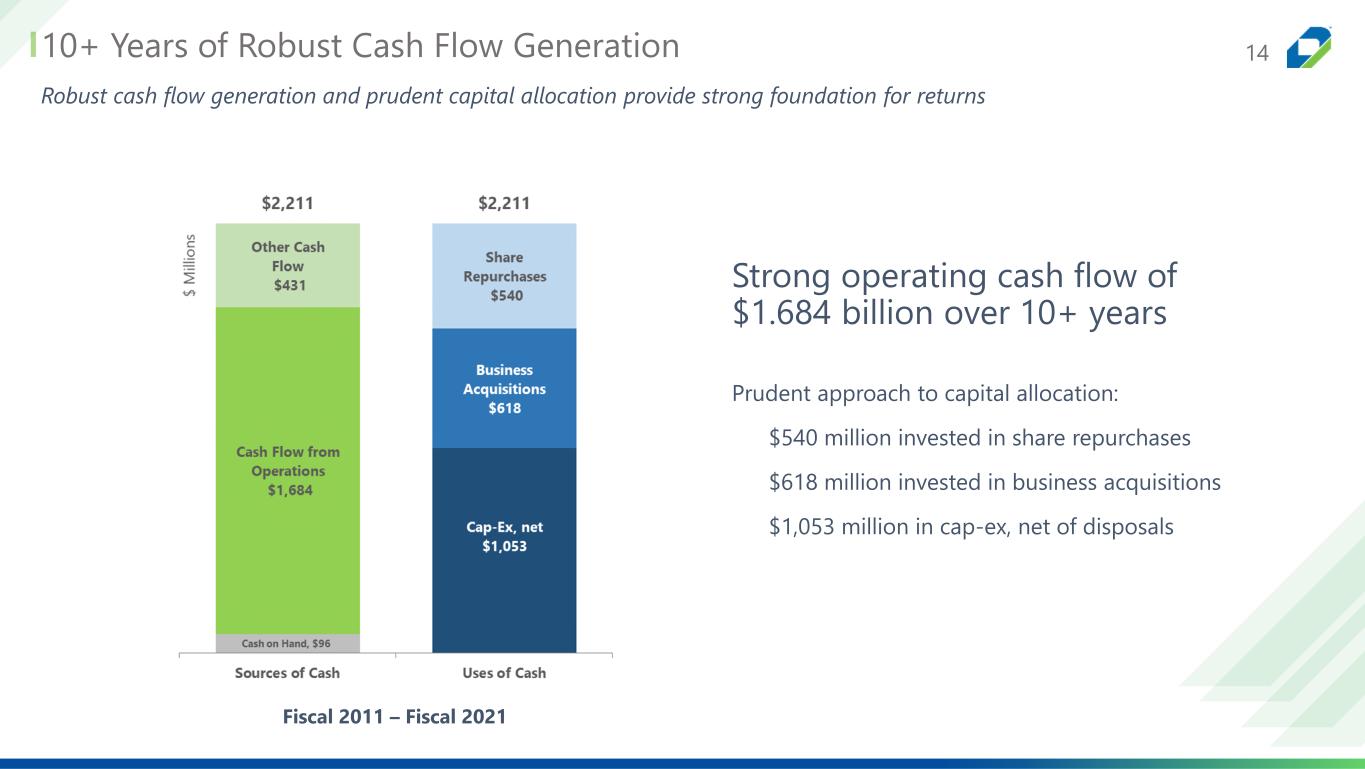
1410+ Years of Robust Cash Flow Generation Fiscal 2011 – Fiscal 2021 Robust cash flow generation and prudent capital allocation provide strong foundation for returns Strong operating cash flow of $1.684 billion over 10+ years Prudent approach to capital allocation: $540 million invested in share repurchases $618 million invested in business acquisitions $1,053 million in cap-ex, net of disposals
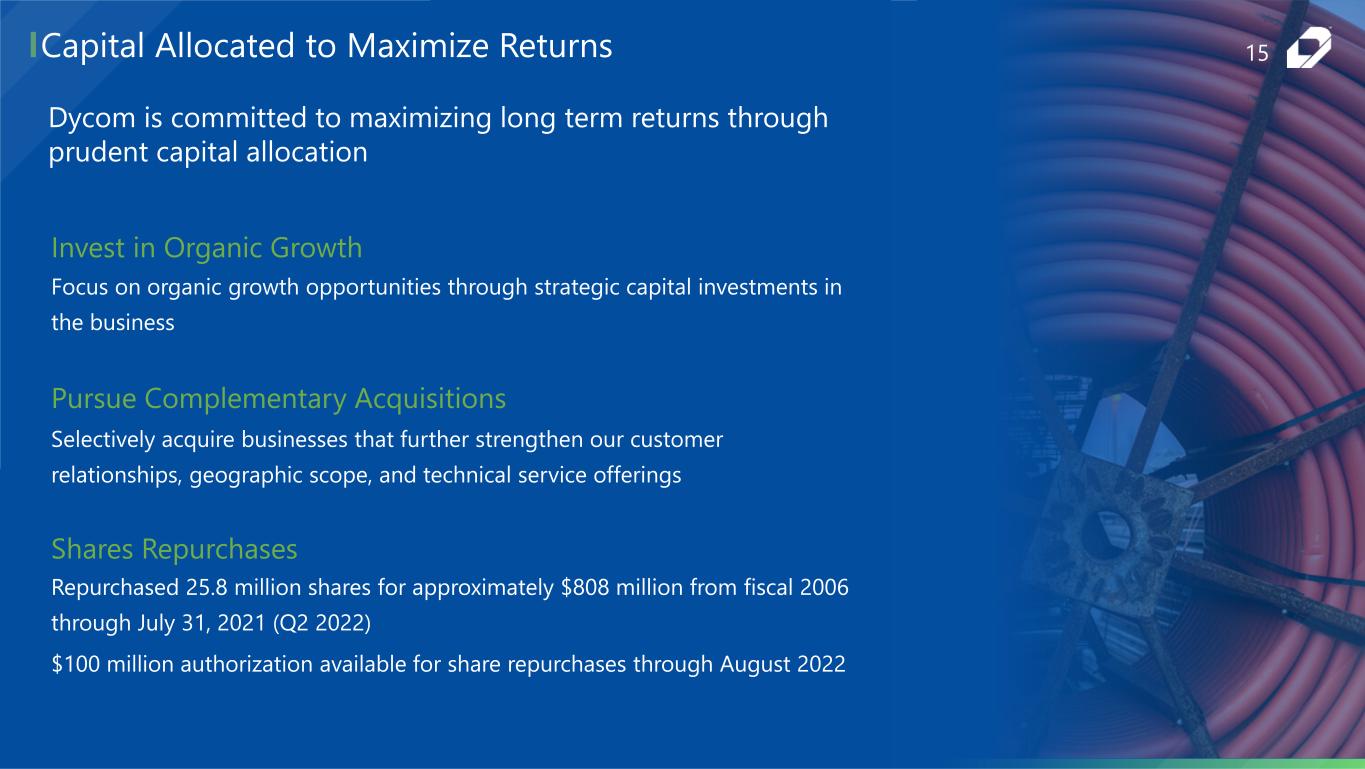
15Capital Allocated to Maximize Returns Focus on organic growth opportunities through strategic capital investments in the business Dycom is committed to maximizing long term returns through prudent capital allocation Repurchased 25.8 million shares for approximately $808 million from fiscal 2006 through July 31, 2021 (Q2 2022) $100 million authorization available for share repurchases through August 2022 Invest in Organic Growth Shares Repurchases Pursue Complementary Acquisitions Selectively acquire businesses that further strengthen our customer relationships, geographic scope, and technical service offerings
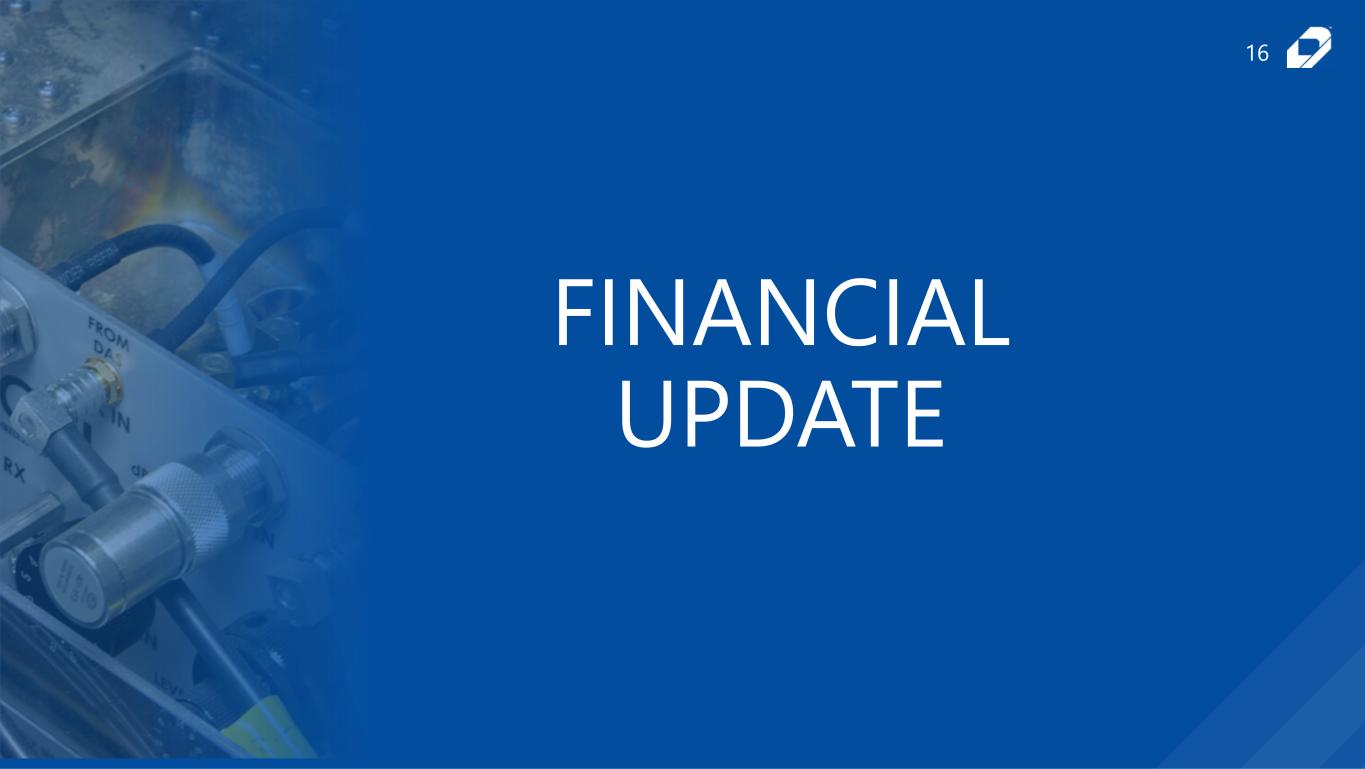
16 FINANCIAL UPDATE
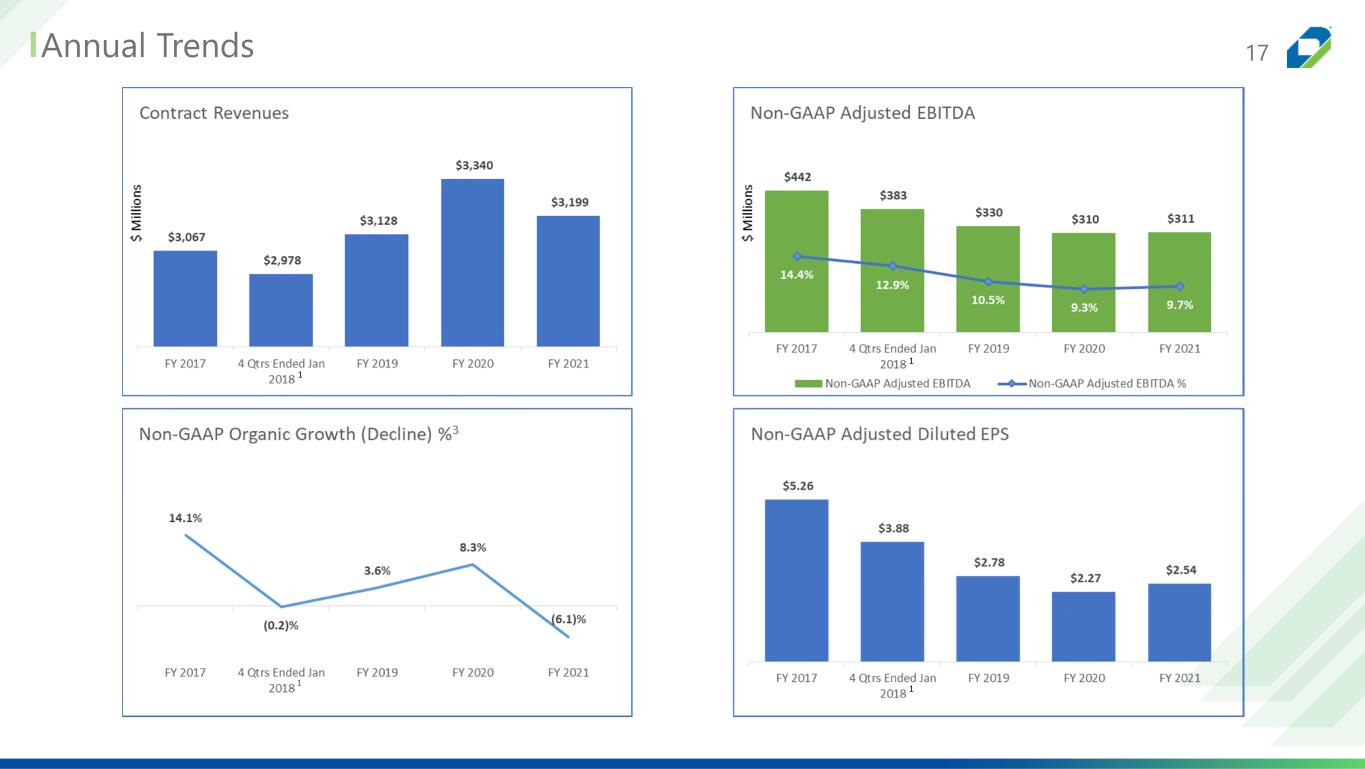
17Annual Trends 1 1 1 1
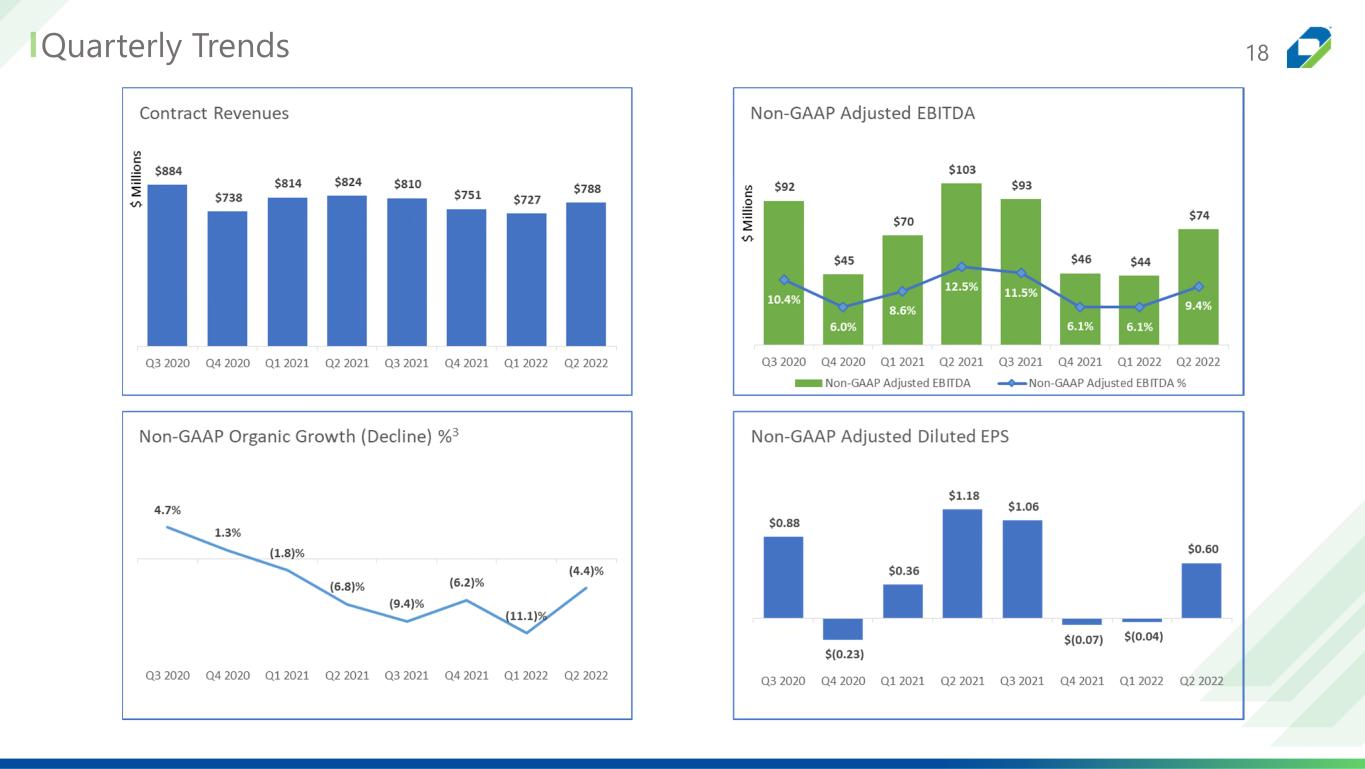
18Quarterly Trends
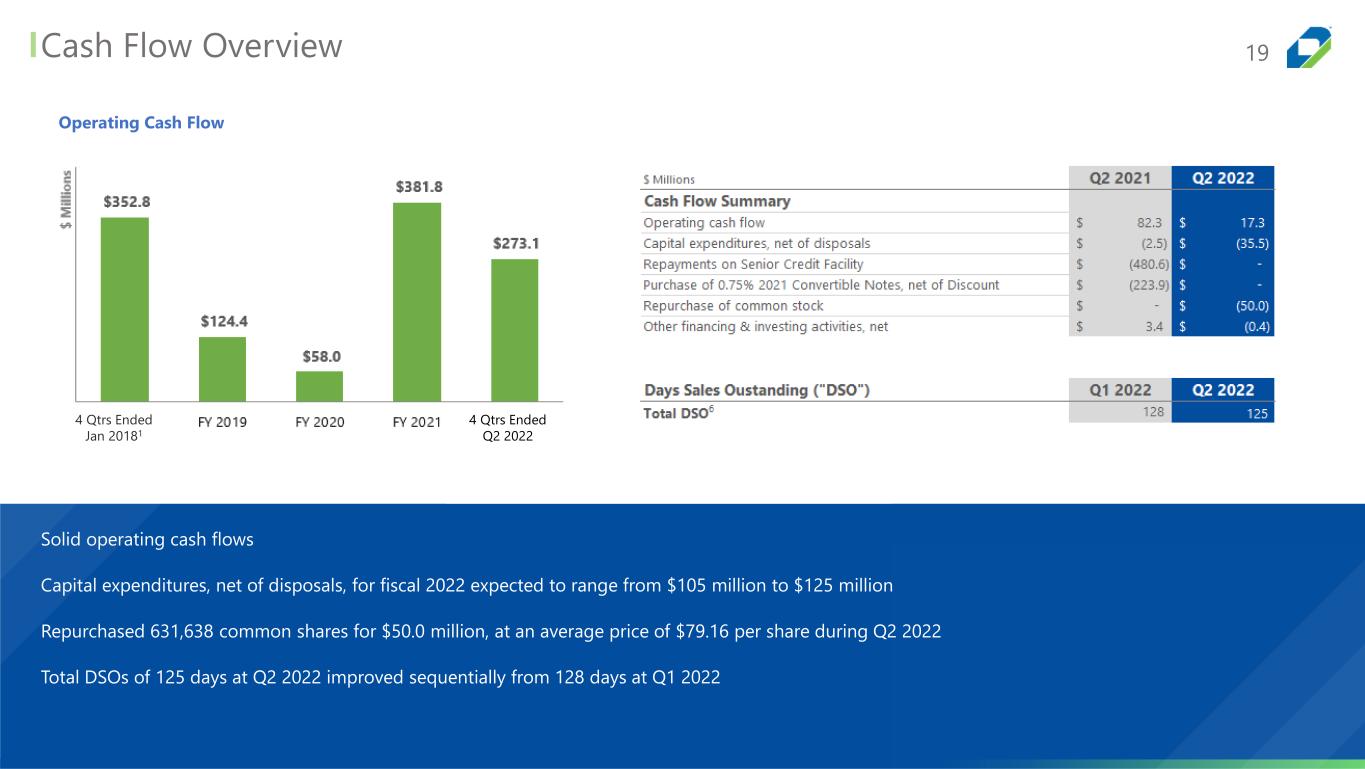
19Cash Flow Overview Solid operating cash flows Capital expenditures, net of disposals, for fiscal 2022 expected to range from $105 million to $125 million Repurchased 631,638 common shares for $50.0 million, at an average price of $79.16 per share during Q2 2022 Total DSOs of 125 days at Q2 2022 improved sequentially from 128 days at Q1 2022 4 Qtrs Ended Q2 2022 Operating Cash Flow 4 Qtrs Ended Jan 20181
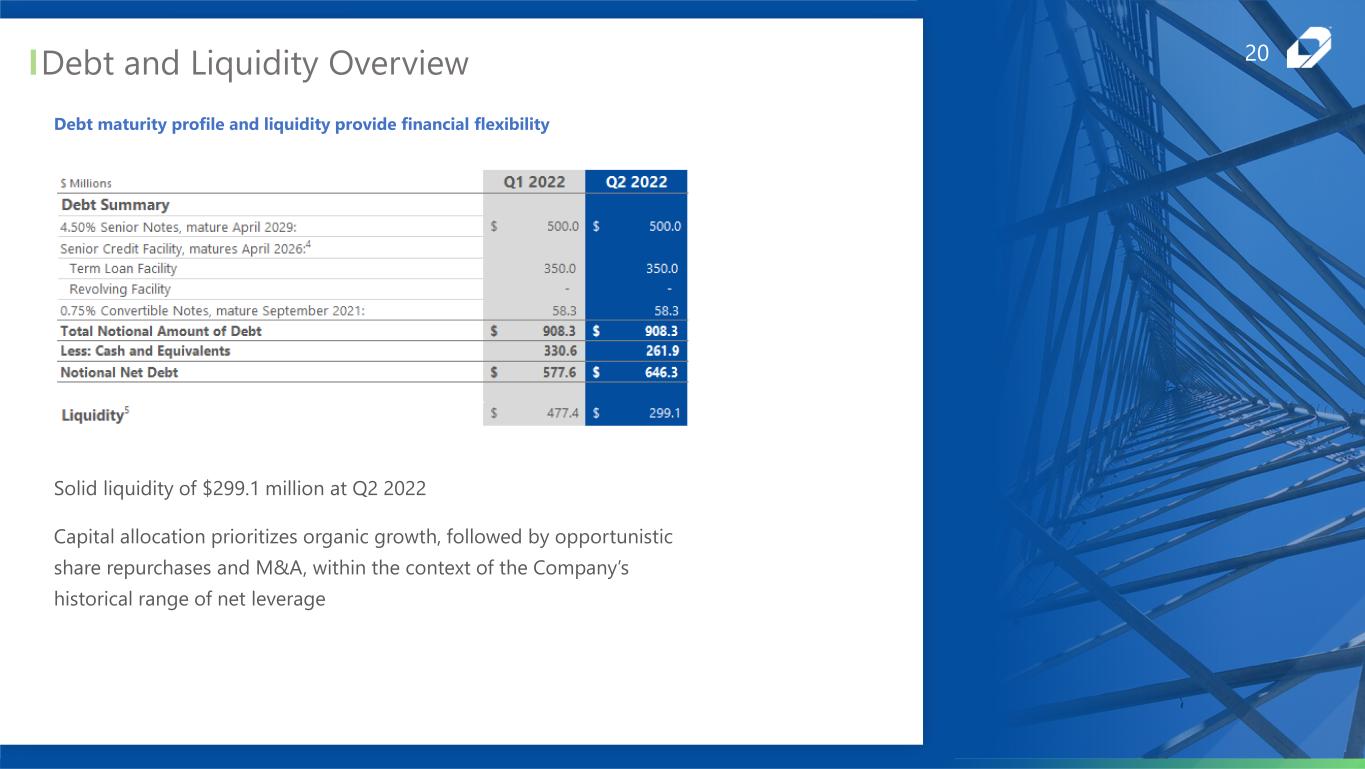
20Debt and Liquidity Overview Solid liquidity of $299.1 million at Q2 2022 Capital allocation prioritizes organic growth, followed by opportunistic share repurchases and M&A, within the context of the Company’s historical range of net leverage Debt maturity profile and liquidity provide financial flexibility

21 QUESTIONS AND ANSWERS
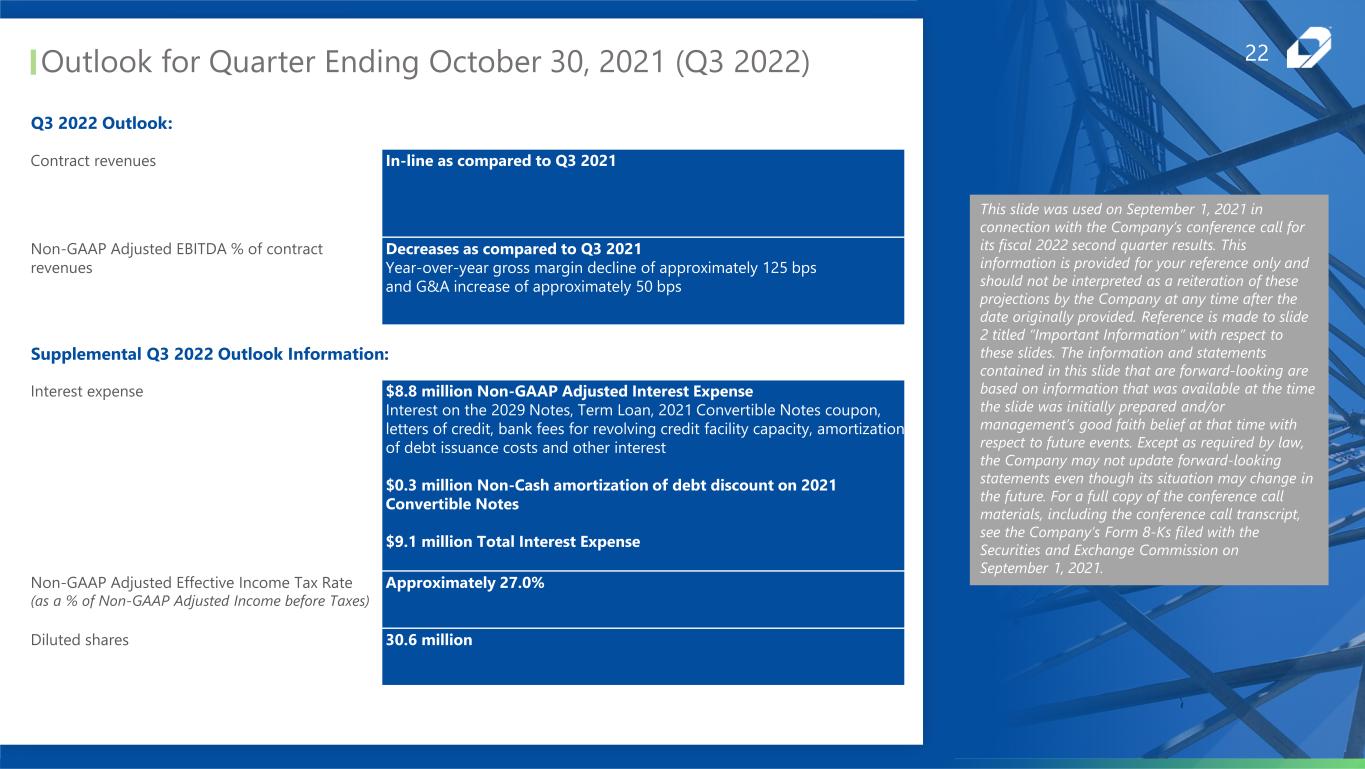
Contract revenues In-line as compared to Q3 2021 Non-GAAP Adjusted EBITDA % of contract revenues Decreases as compared to Q3 2021 Year-over-year gross margin decline of approximately 125 bps and G&A increase of approximately 50 bps Interest expense $8.8 million Non-GAAP Adjusted Interest Expense Interest on the 2029 Notes, Term Loan, 2021 Convertible Notes coupon, letters of credit, bank fees for revolving credit facility capacity, amortization of debt issuance costs and other interest $0.3 million Non-Cash amortization of debt discount on 2021 Convertible Notes $9.1 million Total Interest Expense Non-GAAP Adjusted Effective Income Tax Rate (as a % of Non-GAAP Adjusted Income before Taxes) Approximately 27.0% Diluted shares 30.6 million 22Outlook for Quarter Ending October 30, 2021 (Q3 2022) Supplemental Q3 2022 Outlook Information: Q3 2022 Outlook: This slide was used on September 1, 2021 in connection with the Company’s conference call for its fiscal 2022 second quarter results. This information is provided for your reference only and should not be interpreted as a reiteration of these projections by the Company at any time after the date originally provided. Reference is made to slide 2 titled “Important Information” with respect to these slides. The information and statements contained in this slide that are forward-looking are based on information that was available at the time the slide was initially prepared and/or management’s good faith belief at that time with respect to future events. Except as required by law, the Company may not update forward-looking statements even though its situation may change in the future. For a full copy of the conference call materials, including the conference call transcript, see the Company’s Form 8-Ks filed with the Securities and Exchange Commission on September 1, 2021.
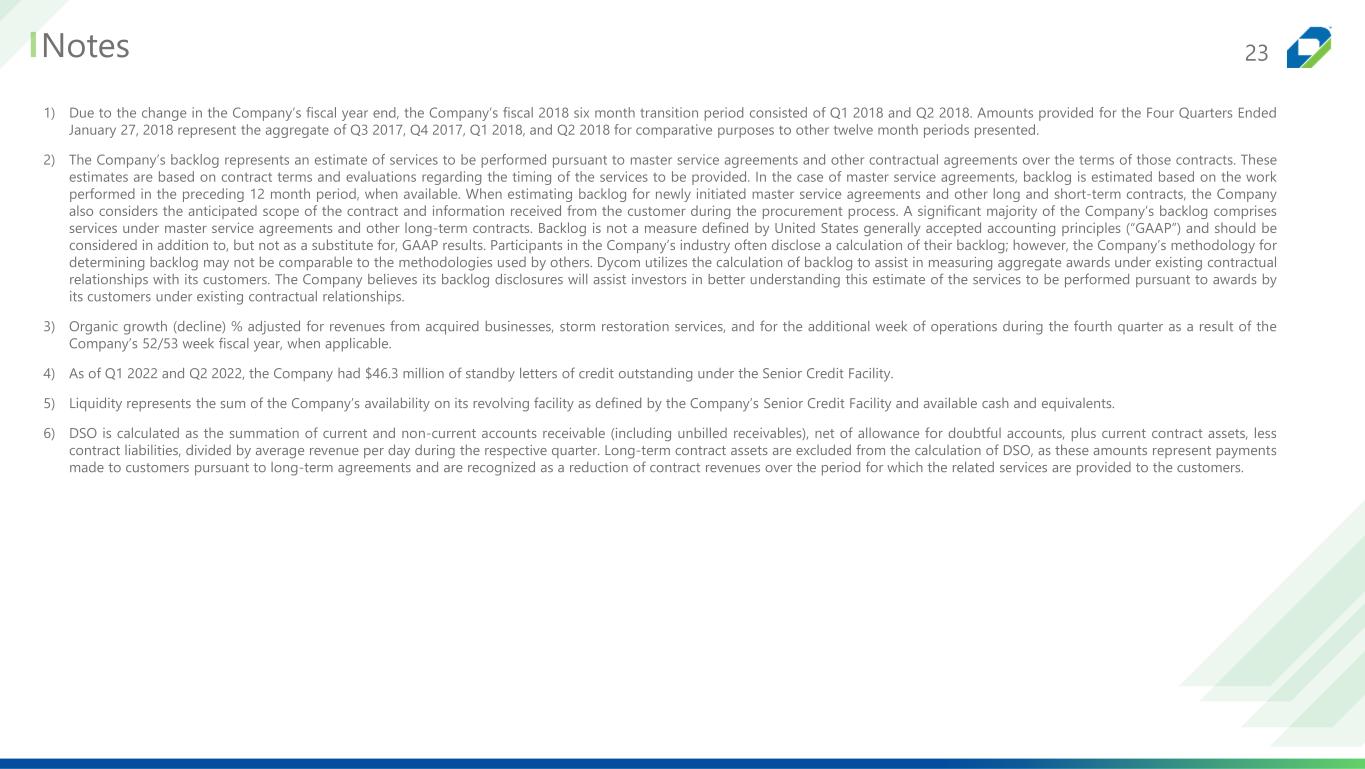
Notes 23 1) Due to the change in the Company’s fiscal year end, the Company’s fiscal 2018 six month transition period consisted of Q1 2018 and Q2 2018. Amounts provided for the Four Quarters Ended January 27, 2018 represent the aggregate of Q3 2017, Q4 2017, Q1 2018, and Q2 2018 for comparative purposes to other twelve month periods presented. 2) The Company’s backlog represents an estimate of services to be performed pursuant to master service agreements and other contractual agreements over the terms of those contracts. These estimates are based on contract terms and evaluations regarding the timing of the services to be provided. In the case of master service agreements, backlog is estimated based on the work performed in the preceding 12 month period, when available. When estimating backlog for newly initiated master service agreements and other long and short-term contracts, the Company also considers the anticipated scope of the contract and information received from the customer during the procurement process. A significant majority of the Company’s backlog comprises services under master service agreements and other long-term contracts. Backlog is not a measure defined by United States generally accepted accounting principles (“GAAP”) and should be considered in addition to, but not as a substitute for, GAAP results. Participants in the Company’s industry often disclose a calculation of their backlog; however, the Company’s methodology for determining backlog may not be comparable to the methodologies used by others. Dycom utilizes the calculation of backlog to assist in measuring aggregate awards under existing contractual relationships with its customers. The Company believes its backlog disclosures will assist investors in better understanding this estimate of the services to be performed pursuant to awards by its customers under existing contractual relationships. 3) Organic growth (decline) % adjusted for revenues from acquired businesses, storm restoration services, and for the additional week of operations during the fourth quarter as a result of the Company’s 52/53 week fiscal year, when applicable. 4) As of Q1 2022 and Q2 2022, the Company had $46.3 million of standby letters of credit outstanding under the Senior Credit Facility. 5) Liquidity represents the sum of the Company’s availability on its revolving facility as defined by the Company’s Senior Credit Facility and available cash and equivalents. 6) DSO is calculated as the summation of current and non-current accounts receivable (including unbilled receivables), net of allowance for doubtful accounts, plus current contract assets, less contract liabilities, divided by average revenue per day during the respective quarter. Long-term contract assets are excluded from the calculation of DSO, as these amounts represent payments made to customers pursuant to long-term agreements and are recognized as a reduction of contract revenues over the period for which the related services are provided to the customers.
